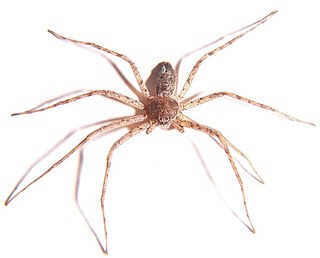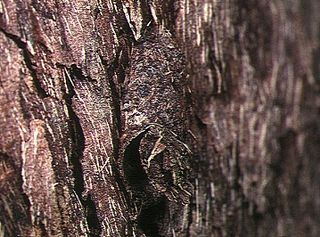
The Mygalomorphae, or mygalomorphs, are an infraorder of spiders, and comprise one of three major groups of living spiders with over 3000 species, found on all continents except Antarctica. Many members are known as trapdoor spiders due to them forming trapdoors over their burrows. Other prominent groups include Australian funnel web spiders, and tarantulas, with the latter accounting for around one third of all mygalomorphs.

The spider family Liphistiidae, recognized by Tamerlan Thorell in 1869, comprises 8 genera and about 100 species of medium-sized spiders from Southeast Asia, China, and Japan. They are among the most basal living spiders, belonging to the suborder Mesothelae. In Japan, the Kimura spider is well known.

Ctenizidae is a small family of mygalomorph spiders that construct burrows with a cork-like trapdoor made of soil, vegetation, and silk. They may be called trapdoor spiders, as are other, similar species, such as those of the families Liphistiidae, Barychelidae, and Cyrtaucheniidae, and some species in the Idiopidae and Nemesiidae. The name comes from the distinctive behavior of the spiders to construct trapdoors, and ambush prey from beneath them.

The wafer trapdoor spiders, family Cyrtaucheniidae, are a widespread family of spiders that lack the thorn-like spines on tarsi and metatarsi I and II found in true trapdoor spiders (Ctenizidae).

Philodromidae, also known as philodromid crab spiders and running crab spiders, is a family of araneomorph spiders first described by Tord Tamerlan Teodor Thorell in 1870. It contains over 500 species in thirty genera.

Idiopidae, also known as armored trapdoor spiders, is a family of mygalomorph spiders first described by Eugène Simon in 1889. They have a large body similar to tarantulas.

Idiosoma is a genus of Australian armored trapdoor spiders that was first described by Anton Ausserer in 1871. Originally placed with the Ctenizidae, it was moved to the armored trapdoor spiders in 1985. The name is derived from the Greek ἴδιος, meaning "individual, unique", and σῶμα, meaning "body", referring to the distinctive structure of the abdomen.

Cyclocosmia is a genus of mygalomorph trapdoor spiders in the family Halonoproctidae, first described by Anton Ausserer in 1871. Originally placed with the Ctenizidae, when the family split in 2018, this genus was placed with the Halonoproctidae as the type genus. The name is derived from the Greek "kyklos" (κυκλος), meaning "circle", and "kosmeo" (κοσμεω), meaning "to adorn".

Tarantulas comprise a group of large and often hairy spiders of the family Theraphosidae. As of August 2022, 1,040 species have been identified, with 156 genera. The term "tarantula" is usually used to describe members of the family Theraphosidae, although many other members of the same infraorder (Mygalomorphae) are commonly referred to as "tarantulas" or "false tarantulas". Some of the more common species have become popular in the exotic pet trade. Many New World species kept as pets have setae known as urticating hairs that can cause irritation to the skin, and in extreme cases, cause damage to the eyes.

The Aviculariinae are a subfamily of spiders in the family Theraphosidae (tarantulas). They can be distinguished from other theraphosids by a number of characters. Their legs have no or few spines on the underside of the tibial and metatarsal joints of the legs. The last two leg joints have brushes of hairs (scopulae) that extend sideways, particularly on the front legs, giving them a spoon-like (spatulate) appearance. Females have two completely separated spermathecae.

The Euctenizidae are a family of mygalomorph spiders. They are now considered to be more closely related to Idiopidae.
Ummidia aedificatoria is a species of trap-door spider found in Portugal, Spain and Morocco. It builds a shallow silk-lined trapdoor burrow, similar to those of U. algeriana and U. picea. Only three female specimens have been positively identified, all ranging from 18 to 29 millimeters in length.
Ummidia algarve is a spider species found in Portugal. Unlike other known Ummidia species, it creates a trapdoor at the entrance of the burrow.

Eucteniza is a genus of trapdoor spiders in the family Euctenizidae containing at least 14 species occurring in Mexico and the southern United States. Species are distinguished by a softened rear portion of the carapace, and males possess large spines on the first two pairs of walking legs that are used to hold females during mating. Like other trapdoor spiders they create burrows with a hinged lid, from which they await passing insects and other arthropods to prey upon. Many species are known from only one or two localities, or from only male specimens. More species are expected to be discovered. Eucteniza is closely related to spiders of the genera Entychides and Neoapachella.
The Ischnocolinae are a problematic subfamily of tarantulas. In 1892, Eugène Simon based the group, which he noted was only weakly homogeneous, on the presence of divided tarsal scopulae. This feature was later considered to be plesiomorphic, and both morphological and molecular phylogenetic studies have shown that, as traditionally circumscribed, the subfamily is not monophyletic. A much more narrowly defined Ischnocolinae sensu stricto was proposed in 2014. One of the authors of that proposal subsequently said that no further taxonomic changes should be considered until there had been a more comprehensive sampling of the subfamily. As of January 2021, the status of the Ischnocolinae remains unresolved.

Latouchia is a genus of Asian mygalomorph spiders in the family Halonoproctidae, first described by Reginald Innes Pocock in 1901. Originally placed with the Ctenizidae, it was moved to the Halonoproctidae in 2018.

Conothele is a genus of mygalomorph spiders in the family Halonoproctidae, first described by Tamerlan Thorell in 1878. Originally placed with the Ctenizidae, it was moved to the Halonoproctidae in 2018.

Avicularioidea is a clade of mygalomorph spiders, one of the two main clades into which mygalomorphs are divided. It has been treated at the rank of superfamily.

Bipectina is a clade of avicularioid mygalomorph spiders first proposed by Pablo A. Goloboff in 1993, based on a morphological cladistic analysis. The clade was marked by a number of morphological features, and in particular by the presence of two rows of teeth on the superior tarsal claws of the legs of both sexes, meaning that the claws were bipectinate. The clade was supported by some subsequent analyses, although not all. A major phylogenetic study in 2020 upheld the monophyly of the clade, which contained 19 of the 25 accepted families of the Avicularioidea.

Cyclocosmia ricketti, commonly known as the Chinese hourglass spider, is a species of trapdoor spider of the genus Cyclocosmia, which refers specifically to mygalomorphus animals. Cyclocosmia ricketti is native to China and it was first described in 1901 by Mary Agard Pocock. They are characterised by their truncated stomach and the rigid disk at the bottom with a pattern.



















